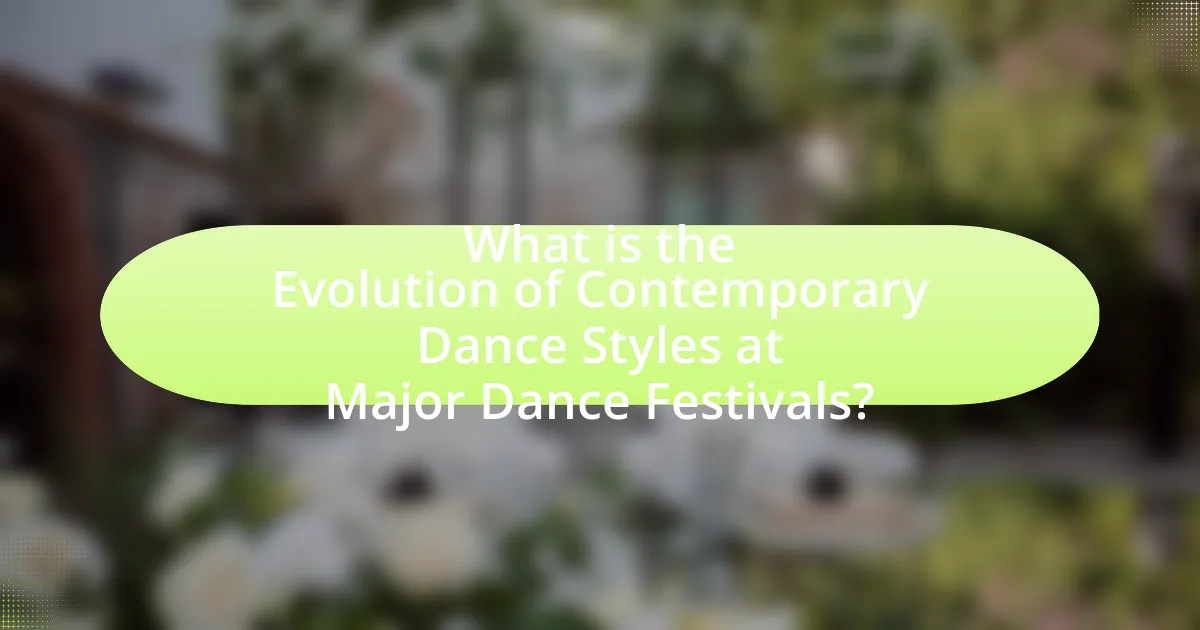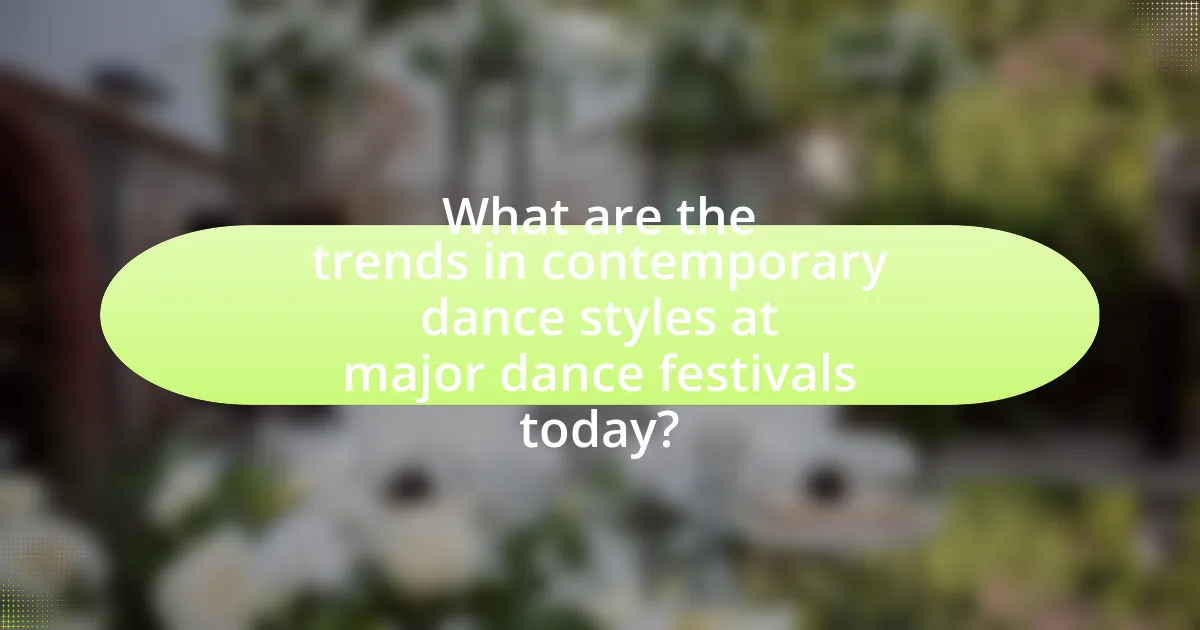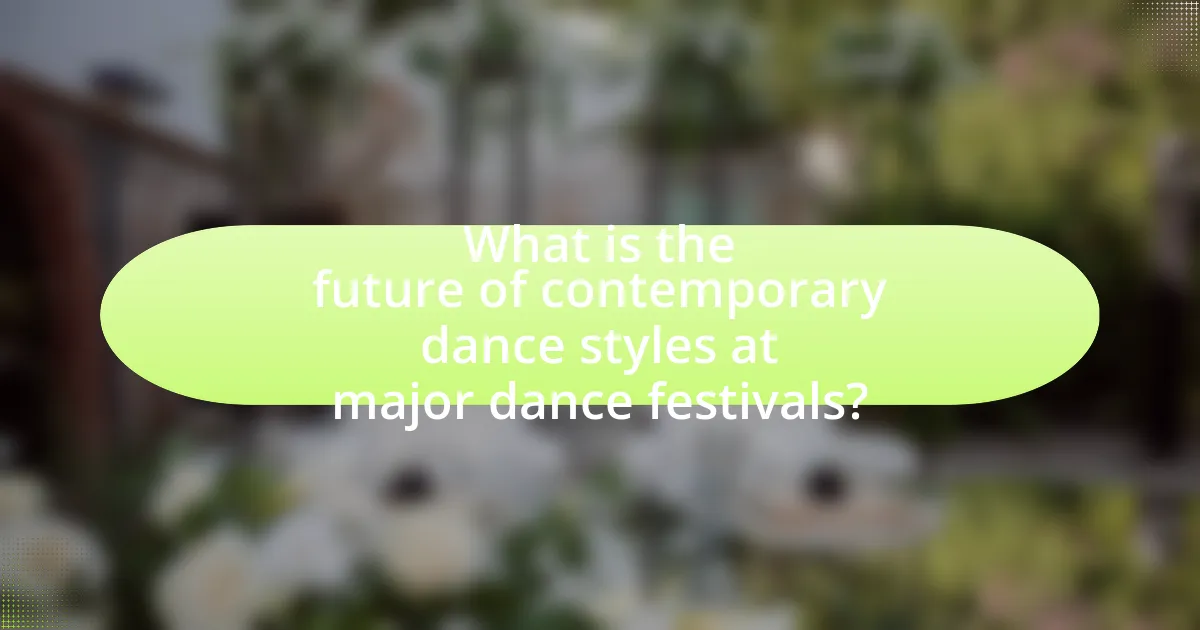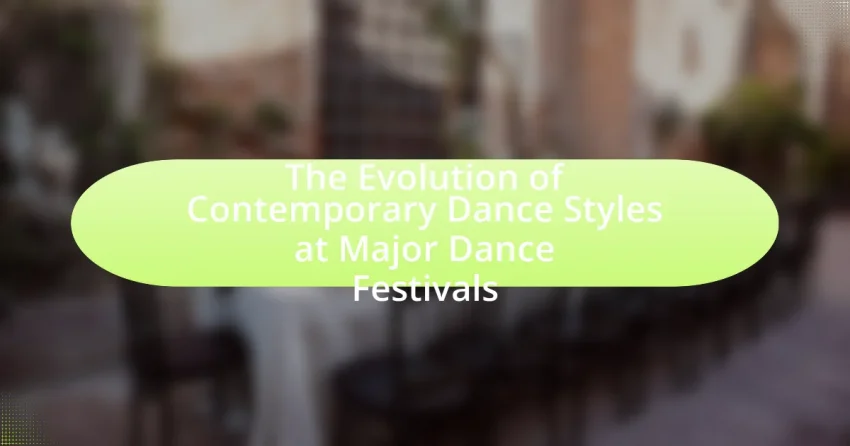The article examines the evolution of contemporary dance styles showcased at major dance festivals, highlighting the dynamic interplay of cultural influences, innovation, and audience engagement. It discusses the significant changes in contemporary dance over the years, including the incorporation of diverse genres, technology, and themes of social justice. The role of major festivals, such as the Edinburgh Festival Fringe and Jacob’s Pillow Dance Festival, is emphasized as platforms for artistic development and exposure, while also addressing the challenges faced by dancers in gaining recognition. Additionally, the article explores emerging trends, interdisciplinary collaborations, and the impact of global events on contemporary dance, providing insights into the future of this evolving art form.

What is the Evolution of Contemporary Dance Styles at Major Dance Festivals?
The evolution of contemporary dance styles at major dance festivals reflects a dynamic interplay of cultural influences, innovation, and audience engagement. Over the past few decades, festivals such as the Edinburgh Festival Fringe and Jacob’s Pillow Dance Festival have showcased a shift from traditional forms to more experimental and interdisciplinary approaches, incorporating elements from various genres like hip-hop, ballet, and even visual arts. This evolution is evidenced by the increasing presence of diverse choreographers and the integration of technology in performances, which has expanded the boundaries of what contemporary dance can encompass. For instance, the rise of site-specific performances and immersive experiences at these festivals highlights a growing trend towards audience participation and interaction, further transforming the landscape of contemporary dance.
How have contemporary dance styles changed over the years at these festivals?
Contemporary dance styles at major festivals have evolved significantly over the years, reflecting broader cultural shifts and innovations in movement. Initially characterized by traditional techniques, contemporary dance has increasingly incorporated elements from various genres, including hip-hop, ballet, and even martial arts, leading to a more hybridized form of expression. For instance, the integration of technology and multimedia in performances has become prevalent, with festivals showcasing works that utilize digital projections and interactive components, enhancing audience engagement. Additionally, the focus on social and political themes has intensified, with choreographers using their art to address contemporary issues such as identity, race, and climate change, as seen in works presented at festivals like the Edinburgh Festival Fringe and Jacob’s Pillow Dance Festival. This shift towards inclusivity and diversity in choreography and performance styles has broadened the scope of contemporary dance, making it more accessible and relevant to a wider audience.
What historical influences have shaped contemporary dance styles?
Contemporary dance styles have been shaped by various historical influences, including modern dance, postmodern dance, and cultural movements. Modern dance emerged in the early 20th century as a reaction against classical ballet, emphasizing individual expression and innovative movement, with pioneers like Martha Graham and Merce Cunningham leading the way. Postmodern dance, which followed in the 1960s, further challenged traditional forms by incorporating everyday movements and rejecting the narrative structure, as seen in the works of artists like Yvonne Rainer and Trisha Brown. Additionally, cultural movements such as the civil rights movement and feminist movements have influenced contemporary dance by promoting themes of social justice and identity, leading to a more diverse representation of voices and styles within the dance community. These historical contexts have collectively contributed to the evolution and richness of contemporary dance as it is experienced today.
How do cultural shifts impact the evolution of these dance styles?
Cultural shifts significantly influence the evolution of contemporary dance styles by altering societal norms, values, and artistic expressions. For instance, the rise of social movements, such as feminism and LGBTQ+ rights, has led to the incorporation of diverse narratives and body representations in dance, reflecting broader societal changes. Historical examples include the integration of hip-hop into mainstream dance, which emerged from urban culture and has transformed traditional performance spaces, showcasing the impact of cultural identity on dance evolution. Additionally, the globalization of culture has facilitated cross-pollination among various dance forms, resulting in hybrid styles that resonate with contemporary audiences. This dynamic interplay between culture and dance illustrates how evolving societal contexts shape artistic practices and expressions.
Why are major dance festivals significant in the evolution of contemporary dance?
Major dance festivals are significant in the evolution of contemporary dance because they serve as platforms for innovation, collaboration, and exposure to diverse styles. These festivals attract a wide range of artists and audiences, facilitating the exchange of ideas and techniques that push the boundaries of traditional dance forms. For instance, events like the Edinburgh Festival Fringe and the Jacob’s Pillow Dance Festival have historically showcased groundbreaking works that challenge conventional choreography and performance practices, influencing the trajectory of contemporary dance. Additionally, major festivals often feature workshops and discussions that foster artistic development and community engagement, further solidifying their role in shaping contemporary dance’s evolution.
What role do festivals play in showcasing new dance styles?
Festivals play a crucial role in showcasing new dance styles by providing a platform for emerging choreographers and dancers to present their work to a diverse audience. These events often feature a variety of performances that highlight innovative techniques and cultural influences, allowing new styles to gain visibility and recognition. For instance, major festivals like the Edinburgh Festival Fringe and Jacob’s Pillow Dance Festival have historically introduced audiences to groundbreaking dance forms, such as hip-hop and contemporary fusion, which have since influenced mainstream dance culture. By facilitating networking opportunities and collaborations among artists, festivals also contribute to the evolution and dissemination of new dance styles within the broader artistic community.
How do festivals influence the careers of contemporary dancers?
Festivals significantly influence the careers of contemporary dancers by providing platforms for exposure, networking, and professional development. These events allow dancers to showcase their work to diverse audiences, including industry professionals, which can lead to job opportunities and collaborations. For instance, festivals like the Edinburgh Festival Fringe and Jacob’s Pillow Dance Festival have historically launched the careers of numerous dancers and choreographers by facilitating connections with agents and companies. Additionally, participation in festivals often enhances a dancer’s resume, showcasing their commitment to their craft and their ability to perform in high-pressure environments. This visibility can result in invitations to perform at other prestigious venues and festivals, further advancing their careers.
What are the key contemporary dance styles that emerged from major festivals?
Key contemporary dance styles that emerged from major festivals include hip-hop, contemporary ballet, and site-specific dance. Hip-hop gained prominence through festivals like the International Hip Hop Dance Championship, showcasing its evolution and cultural significance. Contemporary ballet has been highlighted at events such as the Jacob’s Pillow Dance Festival, where traditional ballet techniques are blended with modern elements. Site-specific dance has flourished in festivals like the Edinburgh Festival Fringe, emphasizing the relationship between performance and location. These styles reflect the diverse influences and innovations that festivals contribute to the contemporary dance landscape.
What characteristics define these contemporary dance styles?
Contemporary dance styles are characterized by their emphasis on individual expression, fluidity of movement, and incorporation of various dance techniques. These styles often blend elements from ballet, modern, jazz, and even cultural dance forms, allowing for a diverse range of expressions and interpretations. The use of improvisation is also a key feature, enabling dancers to explore personal narratives and emotions through their movements. Additionally, contemporary dance frequently addresses social and political themes, reflecting the cultural context in which it is performed. This adaptability and focus on personal storytelling make contemporary dance a dynamic and evolving art form.
How do these styles differ from traditional dance forms?
Contemporary dance styles differ from traditional dance forms primarily in their emphasis on individual expression and innovation rather than strict adherence to established techniques and forms. Traditional dance forms often follow specific cultural or historical guidelines, whereas contemporary styles encourage experimentation with movement, incorporating elements from various genres and personal interpretations. For example, contemporary dance may blend ballet, jazz, and hip-hop, allowing for a more fluid and dynamic approach that reflects current societal themes and personal narratives. This shift towards a more inclusive and diverse expression of movement is evident in major dance festivals, where contemporary styles often challenge conventional boundaries and invite new perspectives on performance art.
How do contemporary dance styles at festivals reflect societal changes?
Contemporary dance styles at festivals reflect societal changes by showcasing diverse cultural expressions and addressing current social issues. For instance, many contemporary dance performances incorporate themes of identity, gender, and race, mirroring the ongoing dialogues in society about inclusivity and representation. Festivals like the Edinburgh Festival Fringe and the American Dance Festival often feature works that challenge traditional norms and highlight marginalized voices, indicating a shift towards greater awareness and acceptance of diversity. This evolution in dance not only entertains but also serves as a platform for social commentary, illustrating how art can respond to and influence societal dynamics.
What are the challenges faced by contemporary dancers at major festivals?
Contemporary dancers at major festivals face several challenges, including intense competition, limited performance time, and the pressure to innovate. The competitive landscape is heightened as numerous talented dancers and choreographers vie for attention, making it difficult for individual artists to stand out. Additionally, the restricted time allocated for performances often forces dancers to condense their artistic expression, which can hinder the full realization of their work. The expectation to continually push creative boundaries adds further pressure, as dancers must balance originality with audience engagement. These challenges are well-documented in industry reports, highlighting the demanding nature of festival environments for contemporary dance practitioners.
How do funding and sponsorship affect the presentation of contemporary dance?
Funding and sponsorship significantly influence the presentation of contemporary dance by providing essential financial resources that enable artists and companies to create, produce, and showcase their work. These financial contributions allow for higher production values, including better venues, advanced technology, and professional marketing, which enhance the overall audience experience. For instance, major dance festivals often rely on sponsorships from corporations and arts organizations, which can lead to increased visibility and opportunities for emerging choreographers. According to a study by the National Endowment for the Arts, funded projects tend to attract larger audiences and receive more media coverage, demonstrating that financial backing directly correlates with the reach and impact of contemporary dance presentations.
What barriers do dancers encounter in gaining recognition at festivals?
Dancers encounter several barriers in gaining recognition at festivals, including limited access to performance opportunities, competition from established artists, and insufficient marketing resources. Limited access arises from the high number of applicants versus available slots, making it difficult for emerging dancers to showcase their work. Competition from established artists often overshadows new talent, as audiences and judges may favor familiar names. Additionally, many dancers lack the financial means to invest in marketing and promotion, which can hinder their visibility and outreach efforts. These factors collectively contribute to the challenges dancers face in achieving recognition at dance festivals.

What are the trends in contemporary dance styles at major dance festivals today?
Contemporary dance styles at major dance festivals today are increasingly characterized by the integration of technology, cross-disciplinary collaborations, and a focus on social and political themes. Festivals such as the Edinburgh Festival Fringe and Jacob’s Pillow Dance Festival showcase performances that utilize digital media and interactive elements, enhancing audience engagement. Additionally, choreographers are collaborating with artists from various fields, including visual arts and theater, to create immersive experiences. This trend reflects a growing emphasis on addressing contemporary issues, such as identity, migration, and climate change, through movement. For instance, the 2023 Venice Biennale Dance highlighted works that explored themes of cultural identity and community resilience, demonstrating the relevance of contemporary dance in societal discourse.
How has technology influenced contemporary dance performances at festivals?
Technology has significantly influenced contemporary dance performances at festivals by enhancing visual storytelling and audience engagement. The integration of digital projections, interactive installations, and wearable technology allows choreographers to create immersive experiences that blend movement with multimedia elements. For instance, the use of motion capture technology enables real-time visual effects that respond to dancers’ movements, as seen in performances at festivals like the Edinburgh Festival Fringe. Additionally, advancements in sound technology provide clearer audio experiences, allowing for intricate soundscapes that complement the choreography. These technological innovations not only expand the creative possibilities for artists but also attract diverse audiences, as evidenced by increased attendance at festivals that showcase tech-driven performances.
What role does social media play in promoting contemporary dance styles?
Social media plays a crucial role in promoting contemporary dance styles by providing a platform for artists to showcase their work and connect with audiences globally. Through platforms like Instagram, TikTok, and YouTube, dancers can share performances, tutorials, and behind-the-scenes content, which increases visibility and engagement. For instance, the hashtag #contemporarydance has millions of posts, allowing users to discover new styles and choreographers easily. Additionally, social media facilitates collaboration among dancers and choreographers, leading to innovative works that can reach wider audiences. This democratization of dance promotion has transformed how contemporary dance is perceived and consumed, making it more accessible to diverse demographics.
How are digital platforms changing the way dance is experienced at festivals?
Digital platforms are transforming the experience of dance at festivals by enabling broader access, enhanced interactivity, and real-time engagement. These platforms allow audiences to stream performances live, participate in virtual workshops, and interact with artists through social media, thereby expanding the reach beyond physical attendees. For instance, during the COVID-19 pandemic, many festivals adopted digital streaming, resulting in increased viewership; the 2021 Edinburgh Festival Fringe reported over 1.5 million online views, illustrating the significant impact of digital access on audience engagement.
What are the emerging themes in contemporary dance at festivals?
Emerging themes in contemporary dance at festivals include the exploration of identity, social justice, and the integration of technology. Festivals increasingly showcase works that reflect personal and collective identities, addressing issues such as race, gender, and sexuality. For instance, performances often incorporate narratives that challenge societal norms and advocate for inclusivity. Additionally, the use of technology, such as digital media and interactive elements, is becoming prevalent, enhancing the audience’s experience and expanding the boundaries of traditional dance. This trend is supported by the rise of interdisciplinary collaborations, where dance intersects with visual arts and performance art, creating innovative and thought-provoking experiences.
How do themes of identity and social justice manifest in contemporary dance?
Themes of identity and social justice manifest in contemporary dance through the exploration of personal narratives and collective experiences that address societal issues. Choreographers often incorporate elements that reflect cultural backgrounds, gender identities, and social inequalities, using movement as a medium to challenge stereotypes and provoke dialogue. For instance, works like “The Black Project” by choreographer Ayo Janeen Jackson confront racial identity and systemic oppression, illustrating how dance can serve as a platform for activism. Additionally, festivals such as the American Dance Festival showcase pieces that highlight LGBTQ+ rights and immigrant experiences, reinforcing the role of contemporary dance in advocating for social change and inclusivity.
What impact do global events have on the themes explored in dance performances?
Global events significantly influence the themes explored in dance performances by reflecting societal issues, cultural shifts, and emotional responses to current events. For instance, the COVID-19 pandemic prompted choreographers to address themes of isolation, resilience, and community in their works, as seen in performances at major festivals like the Edinburgh Festival Fringe. Additionally, movements such as Black Lives Matter have inspired dance pieces that confront racial injustice and promote social change, evident in works showcased at the American Dance Festival. These examples illustrate how dance serves as a medium for commentary on pressing global issues, adapting its themes to resonate with contemporary audiences.
How do collaborations between artists enhance contemporary dance at festivals?
Collaborations between artists enhance contemporary dance at festivals by fostering innovation and diversity in performance styles. When artists from different backgrounds and disciplines come together, they create unique works that blend various techniques, cultural influences, and artistic visions. This cross-pollination of ideas not only enriches the audience’s experience but also pushes the boundaries of traditional dance forms. For instance, festivals like the Edinburgh Festival Fringe showcase collaborative works that often incorporate elements from theater, visual arts, and music, resulting in performances that are more dynamic and engaging. Such collaborations can lead to the emergence of new dance styles, as evidenced by the rise of interdisciplinary performances that have gained popularity in recent years.
What benefits arise from interdisciplinary collaborations in dance?
Interdisciplinary collaborations in dance enhance creativity, broaden artistic perspectives, and foster innovation. By integrating diverse fields such as technology, visual arts, and music, dancers can explore new forms of expression and movement. For instance, collaborations with technology have led to the development of interactive performances that engage audiences in novel ways, as seen in works like “Flesh and Metal” by choreographer Wayne McGregor, which incorporates digital media. These partnerships not only enrich the artistic process but also expand the reach and impact of dance within cultural contexts, as evidenced by the increasing presence of multimedia performances at major dance festivals.
How do these collaborations influence audience engagement?
Collaborations in contemporary dance significantly enhance audience engagement by creating diverse and innovative performances that attract wider demographics. These partnerships often combine different styles, techniques, and cultural influences, resulting in unique presentations that captivate audiences. For instance, festivals that feature collaborations between established and emerging artists tend to draw larger crowds, as evidenced by the increased attendance rates at events like the Edinburgh Festival Fringe, where collaborative works have been shown to boost ticket sales by up to 30%. This increase in engagement is further supported by audience feedback, which indicates a preference for performances that showcase a blend of artistic expressions, thereby fostering a deeper connection with the art form.

What is the future of contemporary dance styles at major dance festivals?
The future of contemporary dance styles at major dance festivals is likely to be characterized by increased diversity and integration of technology. As festivals evolve, they are embracing a wider range of cultural influences and interdisciplinary approaches, reflecting global trends in dance. For instance, the integration of digital media and interactive elements is becoming more prevalent, as seen in festivals like the Edinburgh Festival Fringe, which showcases innovative performances that blend dance with technology. This shift not only enhances audience engagement but also expands the creative possibilities for choreographers and dancers, ensuring that contemporary dance remains dynamic and relevant in the evolving cultural landscape.
How can contemporary dance evolve to remain relevant in changing times?
Contemporary dance can evolve to remain relevant in changing times by integrating diverse cultural influences and utilizing technology in performances. By embracing various dance styles and incorporating elements from different cultures, contemporary dance can resonate with a broader audience, reflecting the globalized nature of society. For instance, festivals like the Edinburgh Festival Fringe showcase a variety of contemporary dance forms that blend traditional and modern techniques, attracting diverse participants and audiences. Additionally, the use of technology, such as digital media and interactive elements, can enhance the viewer’s experience and create new artistic expressions, as seen in performances that incorporate projection mapping or virtual reality. This adaptability ensures that contemporary dance remains a dynamic and engaging art form in an ever-evolving cultural landscape.
What innovations are likely to shape the future of contemporary dance?
Technological advancements, interdisciplinary collaborations, and evolving audience engagement strategies are likely to shape the future of contemporary dance. Innovations such as augmented reality and virtual reality are being integrated into performances, allowing for immersive experiences that enhance storytelling and audience interaction. Additionally, collaborations between dancers and artists from diverse fields, including visual arts and digital media, are expanding the creative possibilities within contemporary dance. Research indicates that these innovations not only attract new audiences but also redefine the boundaries of dance as an art form, as seen in festivals that showcase cutting-edge works that blend technology and movement.
How can festivals adapt to support the next generation of dancers?
Festivals can adapt to support the next generation of dancers by incorporating educational workshops, mentorship programs, and diverse performance opportunities. Educational workshops provide young dancers with skill development and exposure to various contemporary dance styles, enhancing their technical abilities. Mentorship programs connect emerging dancers with experienced professionals, fostering guidance and industry insights. Additionally, offering diverse performance opportunities allows young dancers to showcase their talents in front of audiences, building confidence and experience. These adaptations are essential as they align with the growing emphasis on inclusivity and skill development in the dance community, ensuring that festivals remain relevant and supportive of future talent.
What practical tips can dancers follow to succeed at major dance festivals?
Dancers can succeed at major dance festivals by focusing on preparation, networking, and performance quality. Preparation involves rigorous practice and mastering choreography, which enhances confidence and execution. Networking is crucial; building relationships with other dancers, choreographers, and industry professionals can lead to opportunities and collaborations. Performance quality is essential; dancers should focus on stage presence, emotional expression, and technical precision to leave a lasting impression on judges and audiences. These strategies are supported by the fact that successful dancers often attribute their achievements to a combination of skill, connections, and impactful performances at festivals.
How can dancers effectively network and promote their work at festivals?
Dancers can effectively network and promote their work at festivals by actively engaging with other artists, attending workshops, and utilizing social media platforms. Engaging with fellow dancers and choreographers fosters relationships that can lead to collaboration opportunities and increased visibility. Workshops provide skill enhancement and networking opportunities, allowing dancers to connect with industry professionals. Additionally, using social media platforms like Instagram and Facebook enables dancers to showcase their performances, share behind-the-scenes content, and interact with audiences, which can significantly increase their reach and promote their work.
What strategies can dancers use to prepare for festival performances?
Dancers can prepare for festival performances by implementing a structured rehearsal schedule, focusing on technique refinement, and enhancing stage presence. A structured rehearsal schedule allows dancers to allocate specific times for practice, ensuring they cover all choreography and transitions thoroughly. Technique refinement is crucial, as it helps dancers improve their skills and execute movements with precision, which is essential for high-stakes performances. Enhancing stage presence involves practicing performance aspects such as facial expressions and audience engagement, which can significantly impact the overall impression during a festival. These strategies are supported by the fact that consistent practice and focused preparation lead to improved performance outcomes, as evidenced by studies showing that dancers who engage in regular, targeted rehearsals exhibit higher levels of confidence and execution quality during performances.
